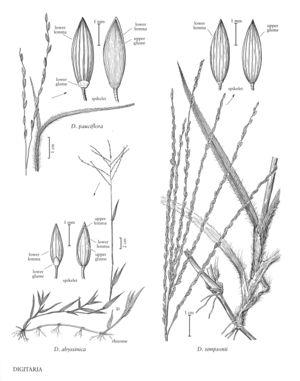Digitaria abyssinica
Plants perennial; rhizomatous, mat-forming. Culms 5-80 cm, decumbent, occasionally rooting at the lower nodes, branching freely at the base, erect portion 20-40 cm; nodes 2-6. Sheaths of midculm leaves glabrous or hirsute, with papillose-based hairs; ligules 0.8-2.1 mm; blades 4-15 cm long, 3-10 mm wide, glabrous or sparsely pubescent with papillose-based hairs. Panicles with 2-25 spikelike primary branches on 1-9 cm rachises; primary branches 2-11 cm, axes not winged or narrowly winged, wings less than 1/2 as wide as the midribs, bearing spikelets in unequally pedicellate pairs; secondary branches rarely present; pedicels not adnate to the branch axes. Spikelets 1.5-2.5 mm long, 0.8-0.95 mm wide, ovate-elliptic to broadly elliptic, usually plump, usually purple-tinged. Lower glumes absent or to 0.8 mm and acute; upper glumes 1.2-2.4 mm, from 0.8 times as long as to almost equaling the spikelets, glabrous, 3-7-veined, veins usually prominent; lower lemmas 1.5-2.5 mm, usually glabrous, occasionally obscurely puberulent on the margins or, very rarely, distinctly pubescent, 7-veined, veins usually prominent; upper lemmas light-brown, gray, and purple. 2n = 36.
Distribution
Pacific Islands (Hawaii)
Discussion
Introduced from Africa, Digitaria abyssinica is not known to be established in the Flora region although it has occasionally been cultivated in the southern United States. It is considered a potentially serious weed threat by the U.S. Department of Agriculture.
Selected References
None.
Lower Taxa
"decumbent" is not a number."timesaslongastoalmostequalingthespikelets" is not declared as a valid unit of measurement for this property.
